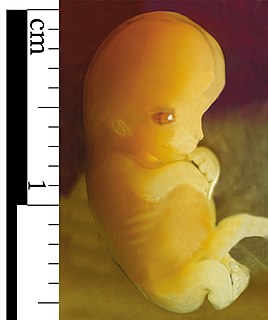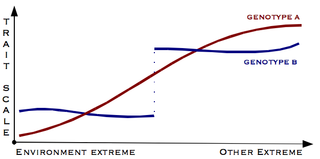Related Research Articles
Developmental biology is the study of the process by which animals and plants grow and develop. Developmental biology also encompasses the biology of regeneration, asexual reproduction, metamorphosis, and the growth and differentiation of stem cells in the adult organism.
Genomic imprinting is an epigenetic phenomenon that causes genes to be expressed in a parent-of-origin-specific manner. Genes however, can also be partially imprinted. Partial imprinting happens when alleles from both parents are differently expressed rather than complete expression and complete suppression of one parents allele. Forms of genomic imprinting have been demonstrated in fungi, plants and animals. As of 2014, there are about 150 imprinted genes known in the mouse and about half that in humans. In 2019, 260 imprinted genes have been reported in mice and 228 in humans.

An embryo is the early stage of development of a multicellular organism. In general, in organisms that reproduce sexually, embryonic development is the part of the life cycle that begins just after fertilization and continues through the formation of body structures, such as tissues and organs. Each embryo starts development as a zygote, a single cell resulting from the fusion of gametes. In the first stages of embryonic development, a single-celled zygote undergoes many rapid cell divisions, called cleavage, to form a blastula, which looks similar to a ball of cells. Next, the cells in a blastula-stage embryo start rearranging themselves into layers in a process called gastrulation. These layers will each give rise to different parts of the developing multicellular organism, such as the nervous system, connective tissue, and organs.

In biology, epigenetics is the study of heritable phenotype changes that do not involve alterations in the DNA sequence. The Greek prefix epi- in epigenetics implies features that are "on top of" or "in addition to" the traditional genetic basis for inheritance. Epigenetics most often involves changes that affect gene activity and expression, but the term can also be used to describe any heritable phenotypic change. Such effects on cellular and physiological phenotypic traits may result from external or environmental factors, or be part of normal development. The standard definition of epigenetics requires these alterations to be heritable in the progeny of either cells or organisms.

Evolutionary developmental biology is a field of biological research that compares the developmental processes of different organisms to infer the ancestral relationships between them and how developmental processes evolved.

In biology, homology is similarity due to shared ancestry between a pair of structures or genes in different taxa. A common example of homologous structures is the forelimbs of vertebrates, where the wings of bats and birds, the arms of primates, the front flippers of whales and the forelegs of four-legged vertebrates like dogs and crocodiles are all derived from the same ancestral tetrapod structure. Evolutionary biology explains homologous structures adapted to different purposes as the result of descent with modification from a common ancestor. The term was first applied to biology in a non-evolutionary context by the anatomist Richard Owen in 1843. Homology was later explained by Charles Darwin's theory of evolution in 1859, but had been observed before this, from Aristotle onwards, and it was explicitly analysed by Pierre Belon in 1555.

Embryology is the branch of biology that studies the prenatal development of gametes, fertilization, and development of embryos and fetuses. Additionally, embryology encompasses the study of congenital disorders that occur before birth, known as teratology.

Drosophila embryogenesis, the process by which Drosophila embryos form, is a favorite model system for genetics and developmental biology. The study of its embryogenesis unlocked the century-long puzzle of how development was controlled, creating the field of evolutionary developmental biology. The small size, short generation time, and large brood size make it ideal for genetic studies. Transparent embryos facilitate developmental studies. Drosophila melanogaster was introduced into the field of genetic experiments by Thomas Hunt Morgan in 1909.

Conrad Hal Waddington CBE FRS FRSE was a British developmental biologist, paleontologist, geneticist, embryologist and philosopher who laid the foundations for systems biology, epigenetics, and evolutionary developmental biology.
The theory of facilitated variation demonstrates how seemingly complex biological systems can arise through a limited number of regulatory genetic changes, through the differential re-use of pre-existing developmental components. The theory was presented in 2005 by Marc W. Kirschner and John C. Gerhart.

Canalisation is a measure of the ability of a population to produce the same phenotype regardless of variability of its environment or genotype. It is a form of evolutionary robustness. The term was coined in 1942 by C. H. Waddington to capture the fact that "developmental reactions, as they occur in organisms submitted to natural selection...are adjusted so as to bring about one definite end-result regardless of minor variations in conditions during the course of the reaction". He used this word rather than robustness to take into account that biological systems are not robust in quite the same way as, for example, engineered systems.
Genetic assimilation is a process described by Conrad H. Waddington by which a phenotype originally produced in response to an environmental condition, such as exposure to a teratogen, later becomes genetically encoded via artificial selection or natural selection. Despite superficial appearances, this does not require the (Lamarckian) inheritance of acquired characters, although epigenetic inheritance could potentially influence the result. Waddington stated that genetic assimilation overcomes the barrier to selection imposed by what he called canalization of developmental pathways; he supposed that the organism's genetics evolved to ensure that development proceeded in a certain way regardless of normal environmental variations.
Developmental systems theory (DST) is an overarching theoretical perspective on biological development, heredity, and evolution. It emphasizes the shared contributions of genes, environment, and epigenetic factors on developmental processes. DST, unlike conventional scientific theories, is not directly used to help make predictions for testing experimental results; instead, it is seen as a collection of philosophical, psychological, and scientific models of development and evolution. As a whole, these models argue the inadequacy of the modern evolutionary synthesis on the roles of genes and natural selection as the principle explanation of living structures. Developmental systems theory embraces a large range of positions that expand biological explanations of organismal development and hold modern evolutionary theory as a misconception of the nature of living processes.

Transgenerational epigenetic inheritance, (TEI), is the transmission of epigenetic markers from one organism to the next that affects the traits of offspring without alteration of the primary structure of DNA —in other words, epigenetically. The less precise term "epigenetic inheritance" may cover both cell–cell and organism–organism information transfer. Although these two levels of epigenetic inheritance are equivalent in unicellular organisms, they may have distinct mechanisms and evolutionary distinctions in multicellular organisms.
Philip William Ingham FRS, FMedSci, Hon. FRCP is a British geneticist, currently the Toh Kian Chui Distinguished Professor at the Lee Kong Chian School of Medicine, a partnership between Nanyang Technological University, Singapore and Imperial College, London. Previously, he was the inaugural Director of the Living Systems Institute at the University of Exeter, UK and prior to that was Vice Dean, Research at the Lee Kong Chian School of Medicine.
Rosa Susan Penelope Beddington FRS was a British biologist whose career had a major impact on developmental biology.

Von Baer's laws of embryology are four rules proposed by Karl Ernst von Baer to explain the observed pattern of embryonic development in different species.
In biology, constructive development refers to the hypothesis that organisms shape their own developmental trajectory by constantly responding to, and causing, changes in both their internal state and their external environment. Constructive development can be contrasted with programmed development, the hypothesis that organisms develop according to a genetic program or blueprint. The constructivist perspective is found in philosophy, most notably developmental systems theory, and in the biological and social sciences, including developmental psychobiology and key themes of the extended evolutionary synthesis. Constructive development may be important to evolution because it enables organisms to produce functional phenotypes in response to genetic or environmental perturbation, and thereby contributes to adaptation and diversification.
Probabilistic epigenesis is a way of understanding human behavior based on the relationship between experience and biology. It is a variant form of epigenetics, proposed by American psychologist Gilbert Gottlieb in 1991. Gottlieb’s model is based on Conrad H. Waddington's idea of developmental epigenesis. Both theories examine the complexity of the ways in which the brain develops and explore factors that occur outside the genome. However, probabilistic epigenesis differs from Waddington’s model as it relies much more heavily on the potential developmental impacts of experience and environment and how they interact with an individual’s genes. Probabilistic epigenesis takes into account developmental, hormonal, environmental, neuropsychological, and genetic factors in order to explain various forms of behavior.
In evolutionary biology, developmental bias refers to the production against or towards certain ontogenetic trajectories which ultimately influence the direction and outcome of evolutionary change by affecting the rates, magnitudes, directions and limits of trait evolution. Historically, the term was synonymized with developmental constraint, however, the latter has been more recently interpreted as referring solely to the negative role of development in evolution.
References
- ↑ Waddington, pp 19–30
- ↑ Waddington, p 32
- ↑ Waddington, p 23
- ↑ Waddington, p 19
- ↑ Waddington, pp 30–33
- ↑ Waddington, pp 34–37
- ↑ Waddington, p 37
- ↑ Waddington, pp 51-52
- ↑ Waddington, p 120
- ↑ Waddington, p 123
- ↑ Sean B Carroll, Endless Forms Most Beautiful, WW Norton & Company, 2005, pp 9, 64–71
- ↑ Sandford Kwinter, "Lecture Excerpt: What Is Life?," GSD 08 Platform, Harvard University Graduate School of Design, page 40.
- ↑ Christopher Alexander, New Concepts in Complexity Theory Arising from Studies in the Field of Architecture, p 17.